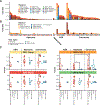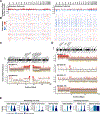Multiomics Profiling Distinguishes Sebaceous Carcinoma from Benign Sebaceous Neoplasms and Provides Insight into the Genetic Evolution of Sebaceous Carcinogenesis
- PMID: 39287419
- PMCID: PMC11530307
- DOI: 10.1158/1078-0432.CCR-24-1327
Multiomics Profiling Distinguishes Sebaceous Carcinoma from Benign Sebaceous Neoplasms and Provides Insight into the Genetic Evolution of Sebaceous Carcinogenesis
Abstract
Purpose: Sebaceous carcinoma is the third most common nonkeratinocyte skin cancer in the United States with 1,000 cases per year. The clinicopathologic features of sebaceous carcinoma and benign sebaceous neoplasms (adenomas, sebaceomas) can overlap, highlighting the need for molecular biomarkers to improve classification. This study describes the genomic and transcriptomic landscape of sebaceous neoplasms in order to understand tumor etiology and biomarkers relevant for diagnosis and treatment.
Experimental design: We performed whole-genome sequencing (WGS) and whole-transcriptome sequencing (WTS) of sebaceous neoplasms from six academic and two federal healthcare facilities in the United States diagnosed between January 1, 1999, and December 31, 2021.
Results: We evaluated 98 sebaceous neoplasms: 64 tumors (32 adenomas, 2 sebaceomas, 5 atypical sebaceous neoplasms, 25 carcinomas) had sufficient material for WGS, 96 tumors (42 adenomas, 11 sebaceomas, 8 atypical sebaceous neoplasms, 35 carcinomas) had sufficient material for WTS, and 62 tumors (31 adenomas, 2 sebaceomas, 5 atypical sebaceous neoplasms, 24 carcinomas) had sufficient material for combined WGS and WTS. Overall, we found decreased cholesterol biosynthesis and increased TP53 mutations, copy number gains (chromosome 6, 8q, and/or 18), and tumor mutation burden-high (>10 mutations/MB) in carcinomas compared to adenomas. Although diminished compared to adenomas, most carcinomas still had higher cholesterol biosynthesis than nonmalignant skin. Multiomics profiling also supported a precancerous model of tumor evolution with sebaceomas and atypical sebaceous neoplasms being likely intermediate lesions.
Conclusions: The study findings highlight key diagnostic biomarkers for sebaceous carcinoma and suggest that immunotherapy and modulation of cholesterol biosynthesis could be effective treatment strategies.
©2024 American Association for Cancer Research.
Conflict of interest statement
Conflict of Interest Disclosure Statement:
The authors declare no potential conflicts of interest.
Figures






References
-
- Surveillance, Epidemiology, and End Results Program. Registry Groupings in SEER Data and Statistics. Available from: https://seer.cancer.gov/registries/terms.html
MeSH terms
Substances
Grants and funding
LinkOut - more resources
Full Text Sources
Research Materials
Miscellaneous

